You may not find this terribly rewarding unless you're included here, so this is a good time for casual and random browsers to turn back before they get too caught up in the sweep and majesty of the proceedings and can't let go.
We're not based in Europe anymore, and we've struggled through the covid-19 lockdowns like everyone else, so we haven't set foot in Italy since February 2019. Now we're making up for lost time with mad sightseeing, but still missing the cats.
The Archbasilica of St John Lateran, and the Holy Stairs
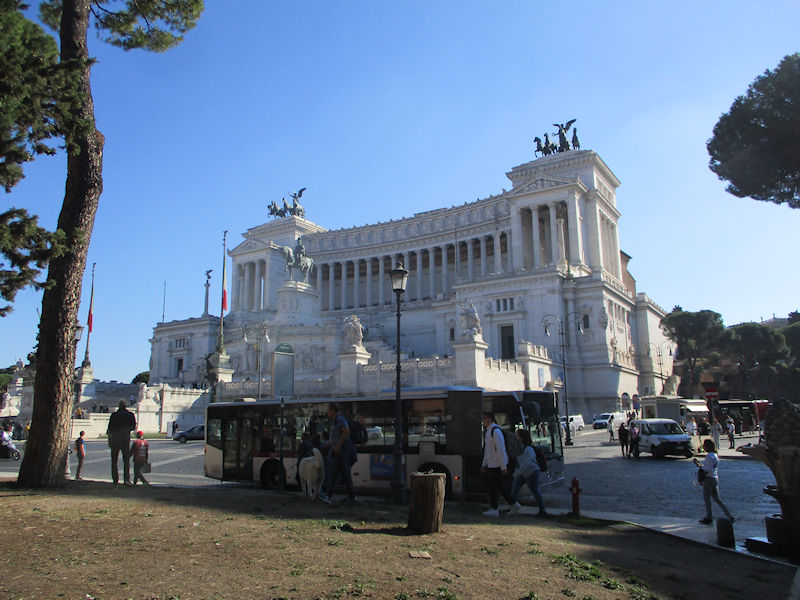
We're off one city bus in the central Piazza di S Marco and waiting for the next one up to the Archbasilica of St John Lateran. This is taken from the nearby Piazza Venezia, and that's the awful 'typewriter', the hugely overstated Victor Emmanuel II National Monument and the Altare della Patria, begun in 1885 to commemorate unified Italy's first king and then the fallen soldiers of World War One as well, and finally completed in 1935.
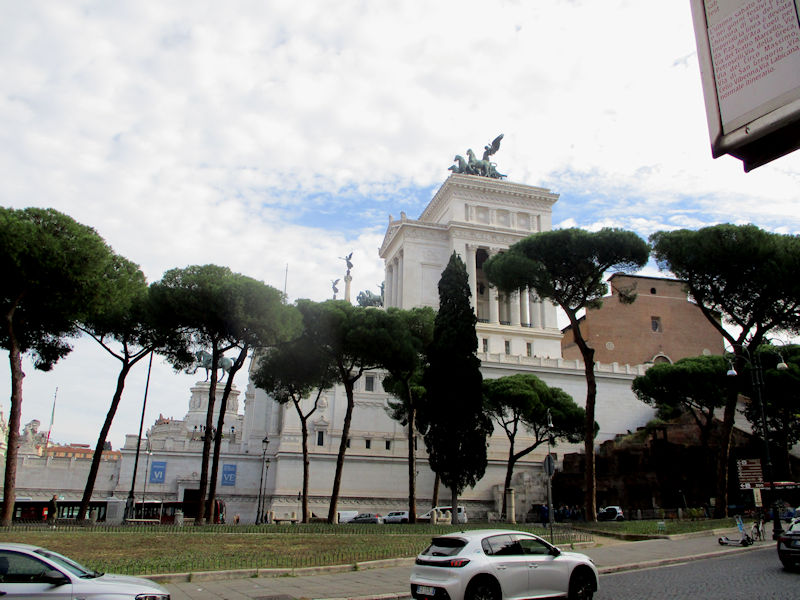
The typewriter seen from the bus stop in the Piazza d'Aracoeli alongside

The skyline to the northeast across the piazza

Whilst we're waiting for the bus, that's the stairway to the Basilica di Santa Maria in Ara Coeli ('the altar of heaven') on the left, and to the Campidoglio in the centre.
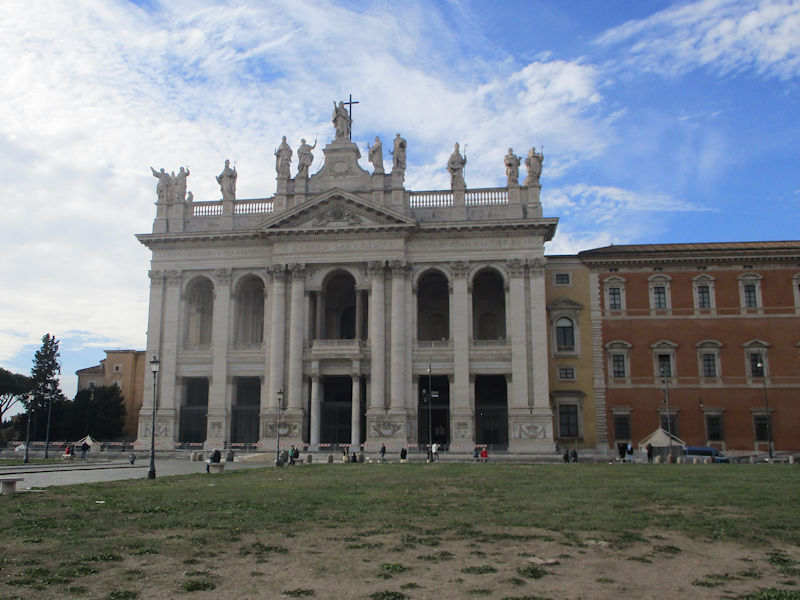
Here's the Basilica di San Giovanni in Laterano on the Caelian Hill to the east of the Colosseum, founded in 324 as the oldest church in Rome, though much altered over the centuries. It still houses the cathedra or throne of the Bishop of Rome and was long the seat of the Pope in his role as Bishop of Rome.
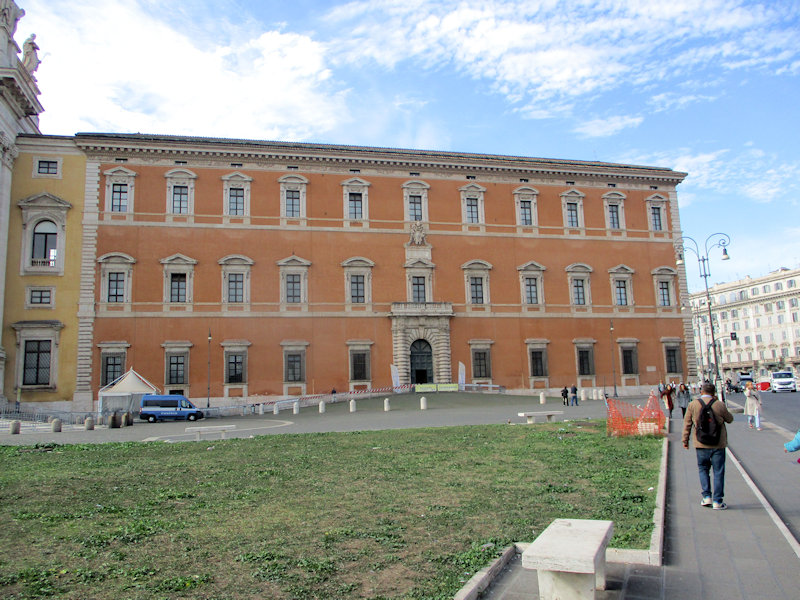
And this, tacked onto the side of the Basilica, is the Lateran Palace, or Apostolic Palace of the Lateran, the chief residence of the popes from the 4th century until the papacy moved to Avignon in 1309, and then, after the return to Rome in 1377, a sojourn at the Santa Maria in Trastevere and then the Santa Maria Maggiore, eventually the old Vatican Palace was rebuilt and better-fortified, and occupied by Pope Nicholas in 1447.
The original Lateran palace had been the residence of the powerful imperial Roman family the Laterani, who served for generations as high-level administrators to the emperors. It came by marriage to Constantine I, who gifted it to the papacy with the site of the first basilica in about 313. Presently the palace houses the Vatican Historical Museum as well as various offices and apartments related to the Cardinal Vicar of Rome.
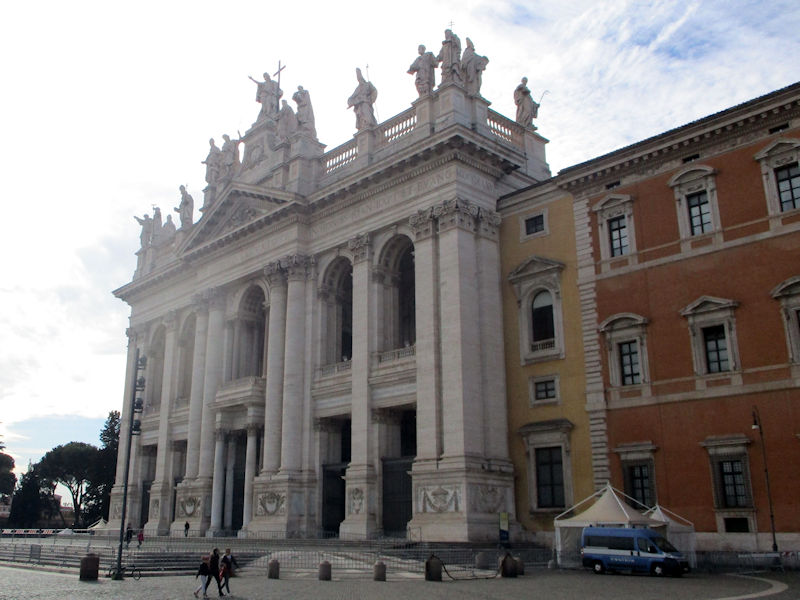
But we'll come back to that anon, when we'll slip politely through the metal-detectors posted in carabinieri tents on both sides of the wired-up front facing the piazza. But first . . .

. . . we've got to dash across the street to catch the Scala Santa in case it closes for lunch.
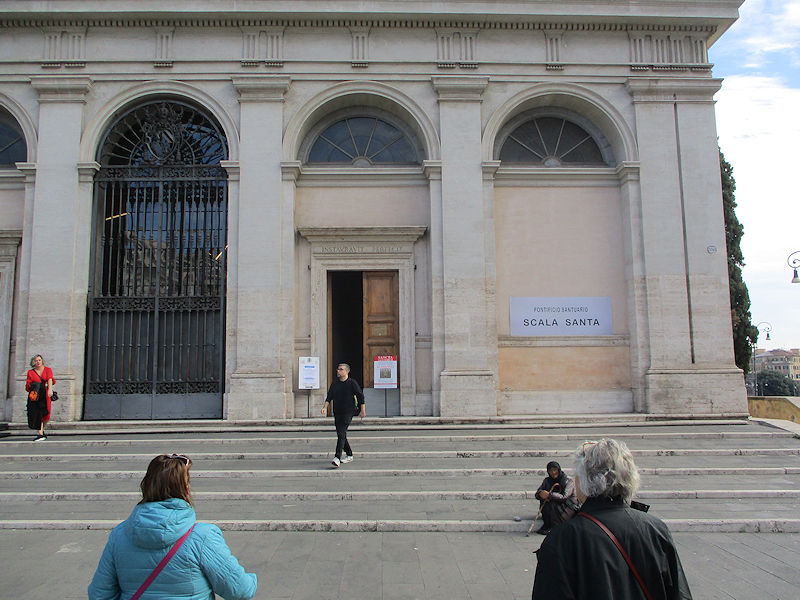
This ought to be fun. As the sign indicates, the Scala Santa is a Pontificio Santuario in the Chiesa di San Lorenzo in Palatio ad Sancta Sanctorum, and a poster by the ticket desk explains that the 'Papal Chapel of the "Sancta Sanctorum" (13th century) inside preserves the ancient image of Jesus called 'Acheropita', i.e., not made by human hands.
Oh wow.
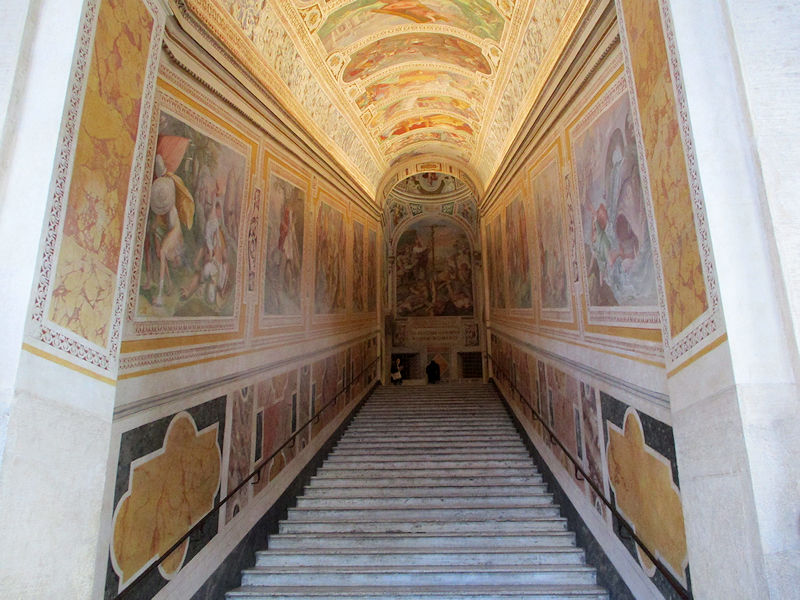
We've got our tickets in hand, but the stairway doesn't look like such a big deal. Sort of nice frescos and all that (they're 16th century but newly restored in 2018). But we're soon enlightened -- that one's not sacred at all. It's one of the four lookalikes flanking the real Scala Santa made in 1589, when Pope Sixtus V demolished the old Lateran Palace and had the Holy Stairs brought over here, leading up to the papal chapel and the Sancta Sanctorum.

Here, in the centre, that's the real Holy Stairs.
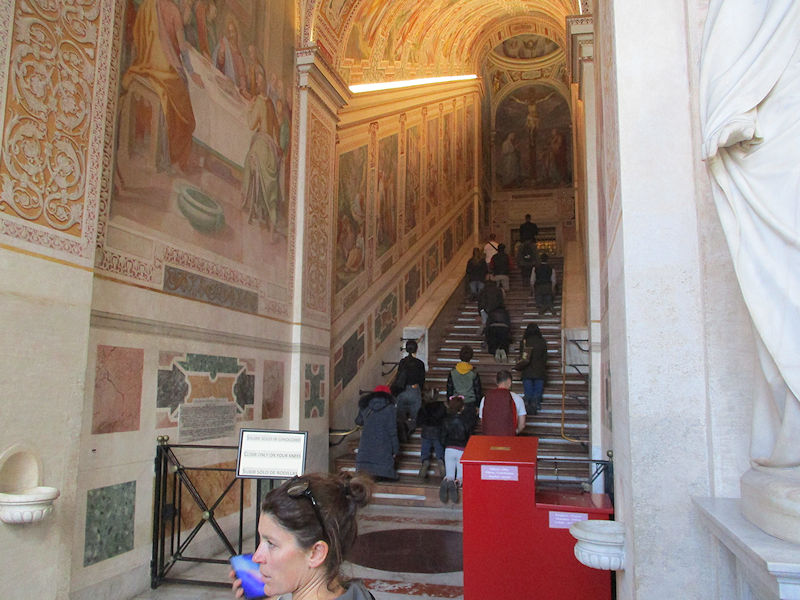
Oh man, they're hiking up it on their knees. According to the sign, that's required. We've been reliably informed that these were the 28 steps that Jesus walked down after his trial in the 'praetorium' of Pontius Pilate in Jerusalem (on three steps, 'blood spots' are still to be seen). They were recovered by Constantine the Great's mother, Saint Helena, when he sent her down to the Holy Land in 326-28 to seek out good relics, and in addition to founding churches she came up with the True Cross (after testing it for authenticity), pieces of Jesus' Holy Tunic, some rope he'd been tied up with, and lots more. Not only that, but she somehow managed to bring this marble staircase back to Rome (and oddly, not to Constantinople).
Helena died a few years later and is interred pretty much everywhere (head's in Trier, but lots of the rest most notably in the Santa Maria in Ara Coeli just down the street. She's the patron saint of new discoveries.)
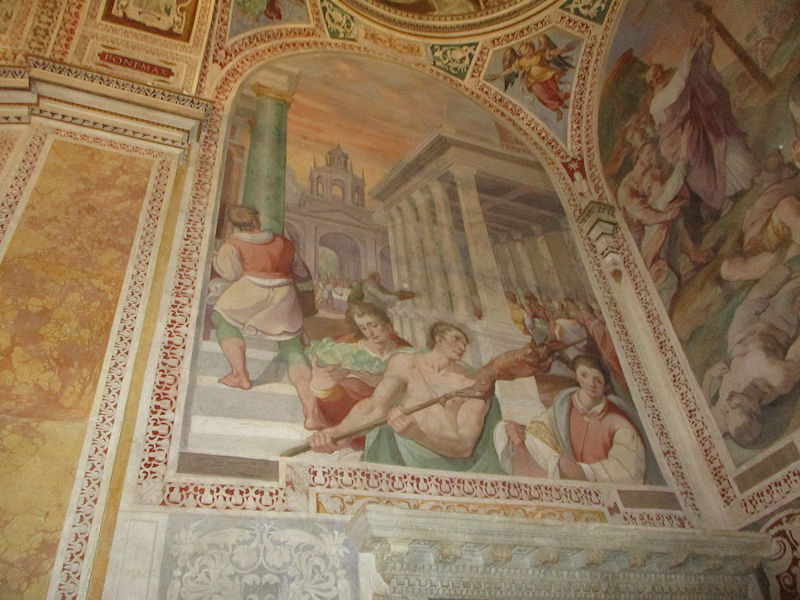
We're giving the knees part a pass and hobbling up the cowards' stairway alongside. Despite damage to one's knees, though, this exercise might be very beneficial, especially in earning time off from Purgatory. In 1817 it was determined that a stair-hiker here could get an indulgence of nine years off Purgatory for every step; in 2015 you could get a plenary indulgence if you went up whilst meditating on Christ's passion, including a prayer for the Pope. We're told that in 1510 the Augustinian friar Martin Luther did the knee-walk but at the top wondered 'Who knows whether this is true?' (Seven years later, 95 theses!). Wikipedia notes that Charles Dickens visited in 1845 and said that he'd never seen anything so ridiculous and unpleasant. To each his own.
But this one isn't a patch on Rocamadour (where, however, it wasn't obligatory).
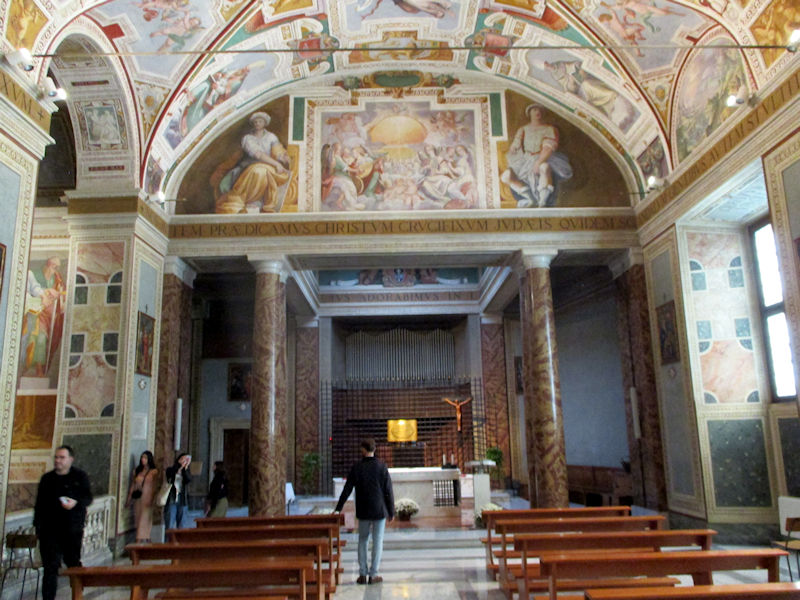
This is the San Lorenzo in Palatio ad Sancta Sanctorum, dedicated to St Lawrence, a 13th century centre within a mainly 16th century building. It was formerly the pope's private palace chapel, first mentioned in documents in the 760s and described as by then an important collection of relics; in fact, the chapel acquired the name Sancta Sanctorum in the early 13th century because of the relics of 13 saints here. After a major earthquake in 1277, the palace, and the chapel, were rebuilt and consecrated in 1279.
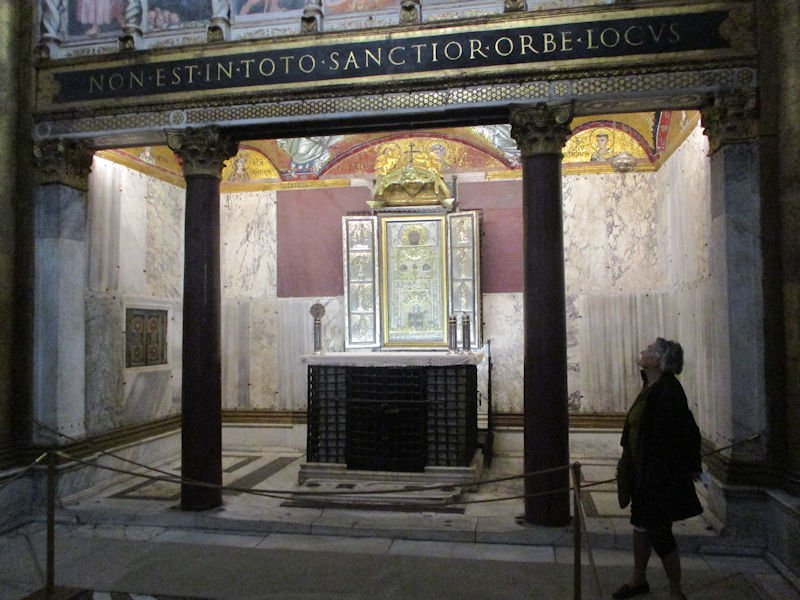
The chapel is free, but if you want to get into the Holy of Holies, the Sancta Sanctorum, you need to show the polite gentleman your ticket. So here we are.
A cypress wooden box under the altar, placed there in the 9th century, once contained the relics of 13 saints, said to include the heads of Saints Peter and Paul, but at some point they were transferred to the Vatican Library. [It would be great to have just a quick look.]

There's an inscription on the wall when you're entering, Magister Cosmatus fecit hoc opus, so the famous Cosmati family where involved or directing the work; of the seven members over four generations, Cosimo is the 'magister' mentioned here.

The little nave is only seven metre on each side, and the rectangular apse is only about 3 by 6 metres.

The Acheropita, or untouched-by-human-hands, was said to have been begun by Apostle Luke and completed by angels. It's generally dated to the 5th century, but uncertainly, given the condition of the original paintwork. It's first mentioned in documents in the 750s when it was hauled out for a procession averting barbarian invaders. The two side panels are the work of the 15th century.
The religiosity of the thing isn't for us to doubt, but aesthetically, well, it's got gold on it and all, but . . . to each his own.

Deeply meaningful portraits of saints and apostles and angels and what not, but for venerating and adoring, that sort of thing, you'd probably have to be in the mood. A lot of European village churches we've peeked into could probably compete fairly well.

But this, on the other hand, is something else: “Pars Lectuli in Quo D. N. Feria V in Coena Recubuit.” The Last Supper Bench that Our Lord Sat Upon. Now that's a relic worth keeping.
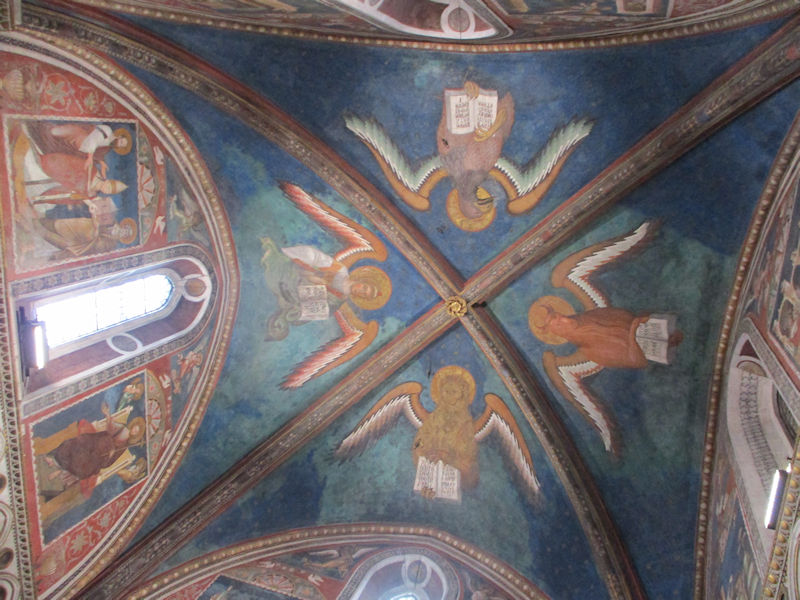
Apostles with wings and gospels, apparently
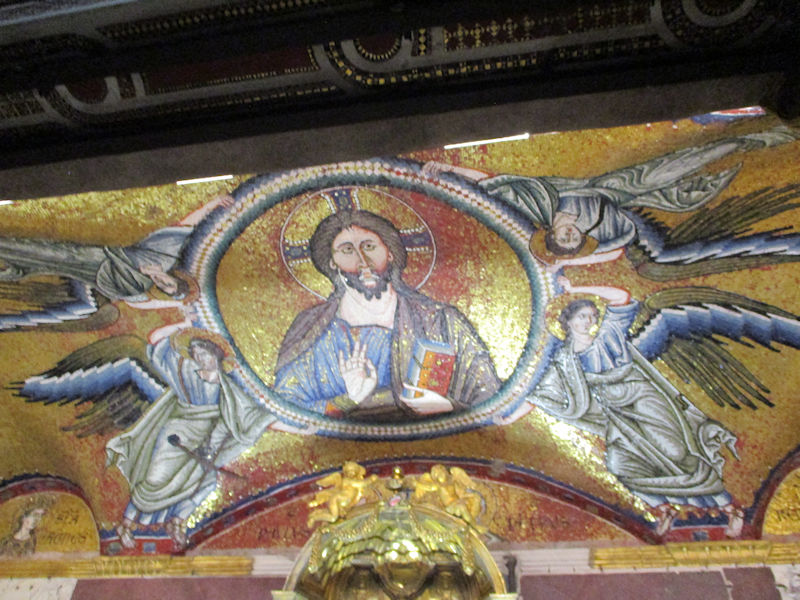
Christ Pantocrator and four angels
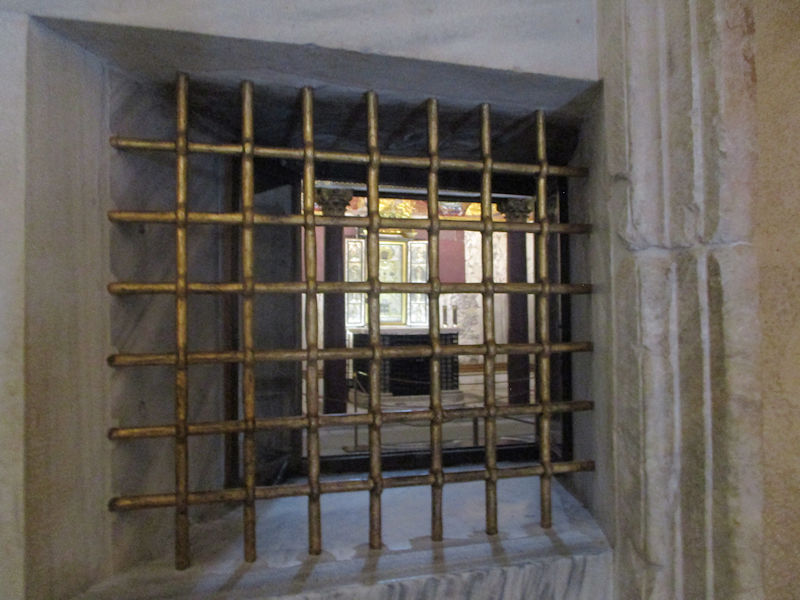
Now here's your view of the Acheropita if you hadn't sprung your €3 (geriatric price) to get into the Sancta Sanctorum.

Back out to the San Lorenzo in Palatio church . . .
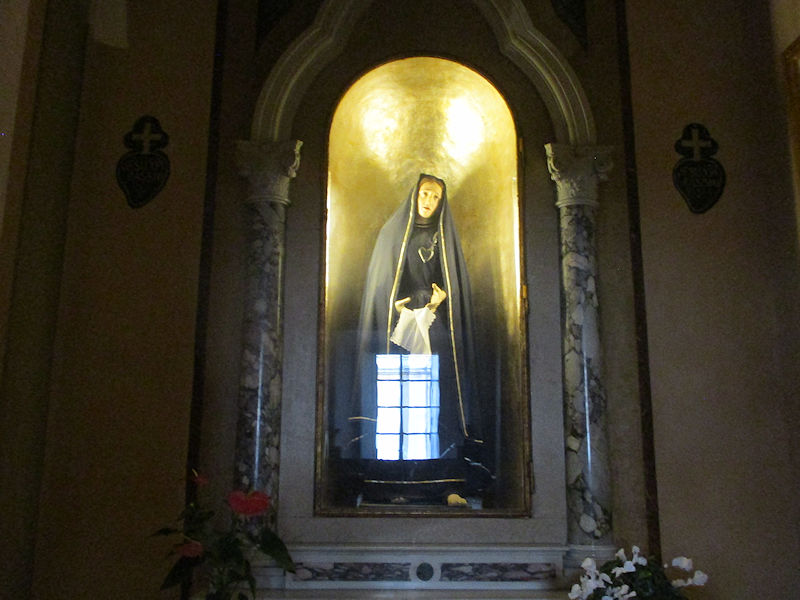
. . . then round the back for some of the additional features.

Uh oh, perhaps it's time to leave.
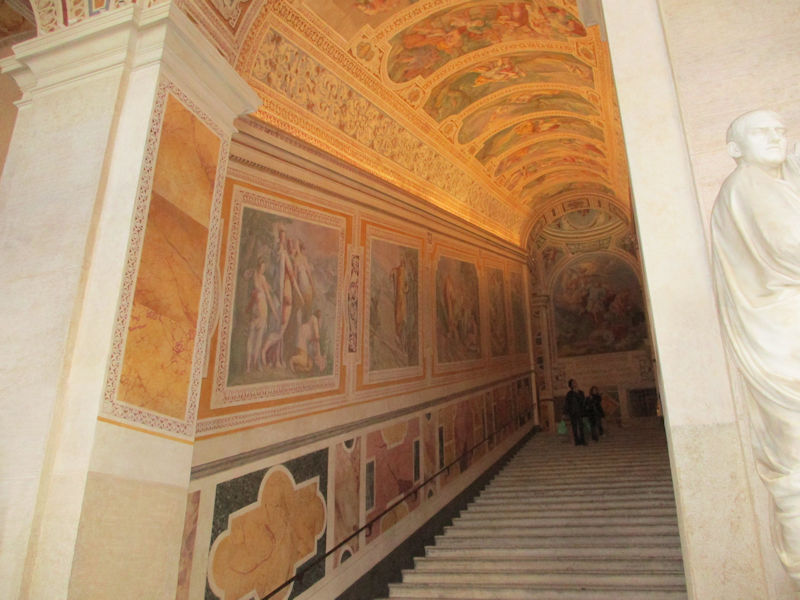
Down the exit stairs now, and back to the Basilica itself

Now for the Archbasilica of Saint John Lateran, the oldest of the public churches in Rome; it's not now part of the 'sovereign' Vatican City, but according to the Lateran Treaty of 1929 the basilica, palace, and Sancta Sanctorum across the street fall under the extraterritorial status within the Italian state as a property of the Holy See.
As mentioned above, the then-Lateran Palace and the site of the Basilica were gifted to the papacy by the Emperor Constantine I in about 313, and the first basilica was dedicated in 324 by Pope Sylvester I. The church was rededicated to John the Baptist in the 10th century and to John the Evangelist in the 12th, so they're listed as co-patrons with Christ as still the chief Patron.
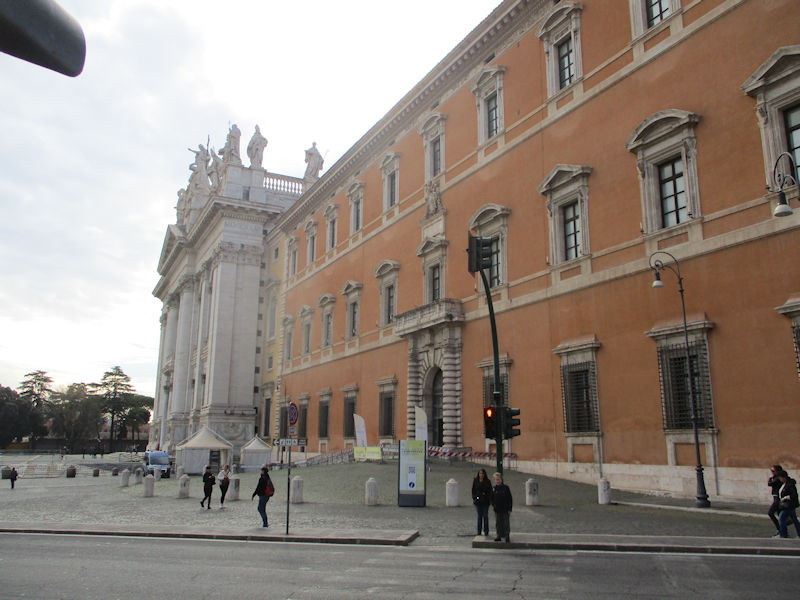
Through the carabinieri metal detectors and . . .
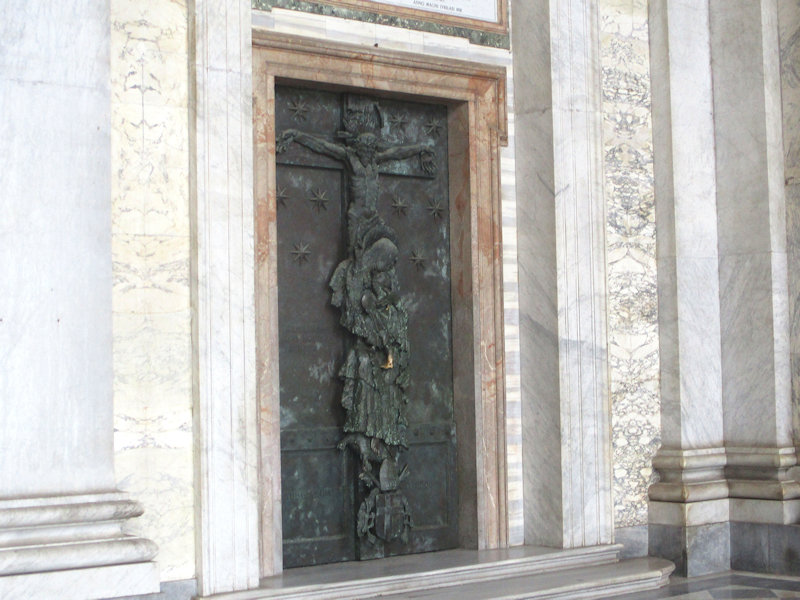
. . . up to one of the front doors. We'll pass on this one and try another.
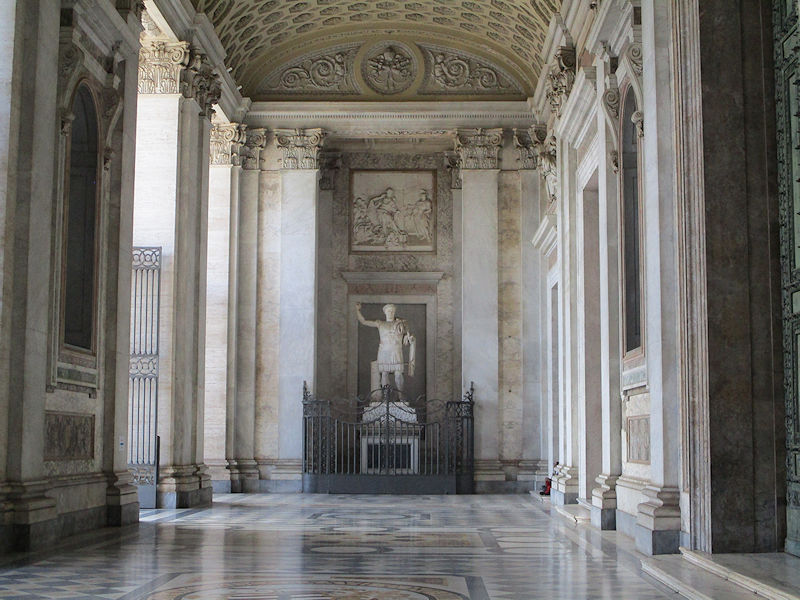
As a preliminary, there in the narthex is what's described as a 4th century statue of the Emperor Constantine I, found somewhere else in Rome and moved up here in the 1730s.
Over time, and especially after two serious fires in the 14th century and the absence of the papal curia in Avignon throughout, the Lateran basilica and palace had deteriorated and the papal court, returning to Rome in 1377, located elsewhere in Rome and eventually into an entirely rebuilt 'Apostolic Palace' in the Vatican in 1447, where they've remained.

The first basilica was sacked by the Vandals in 455 and nearly wrecked by an earthquake in 897. Its replacement suffered from two fires and a certain neglect during the 14th century, but major works were carried out by Clement XII in the 1730s, with a new façade in 1735.

In the early 18th century, a set of 12 monumental statues was created of the apostles (except Judas Iscarot, with St Paul in his place), by a number of sculptors, to fill the niches created by Borromini and left vacant for decades. All of them seem to be differentiated by iconographic symbols, but at the same time they can all be described as intense, angry, muscular, threatening, and probably overdressed. That's St Matthew with his book.

St Thomas, not looking Doubting about anything
 3
3
That's the ciborium over the altar, planted right in the middle of everything, in a very nice Gothic design from 1369.

The souvenirs are over this way, on the right.

The ciborium, or baldachin, covering the main altar
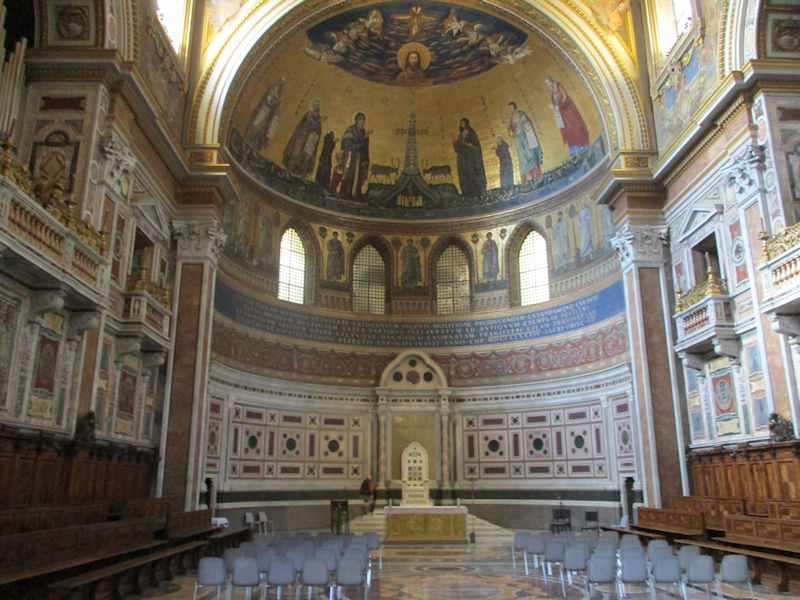
That's the cathedra at the back of the apse, the raised throne of the Bishop of Rome, originally any armchair but then the throne of the Emperor, adopted by the church for its bishops and their sees. A bishop's church with its cathedra became the cathedral.

The nave from behind the altar. The high altar (there in the centre of it) houses a relic of the wooden altar used by St Peter (we've been informed).
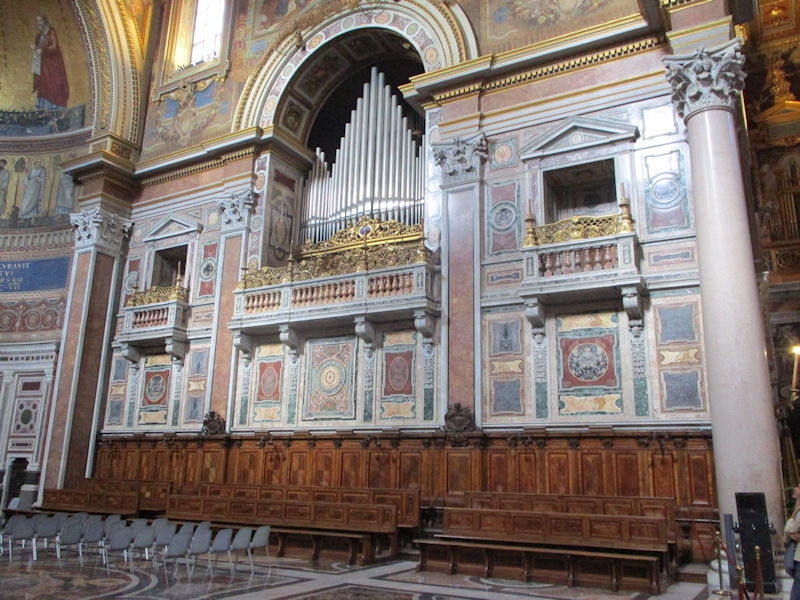
The organ in the apse

Around the top of the ciborium are images of the lives of Saints Peter and Paul, co-patrons of the church
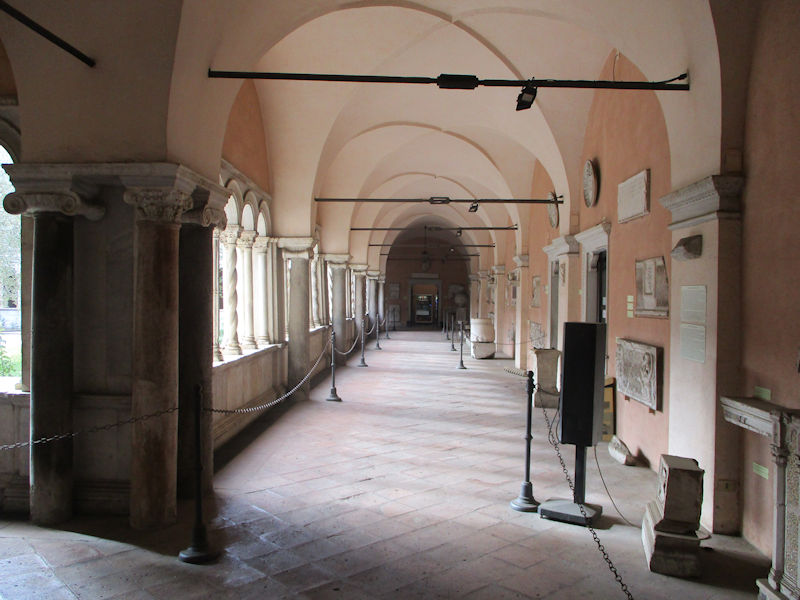
There was once a significant Benedictine monastery here, between the basilica and the city walls out behind it, housing a bunch of monks who were meant to provide the services for the facilities. All that remains of that is this beautiful 13th century Romanesque and Gothic cloister, much of it the work of the Cosmati.
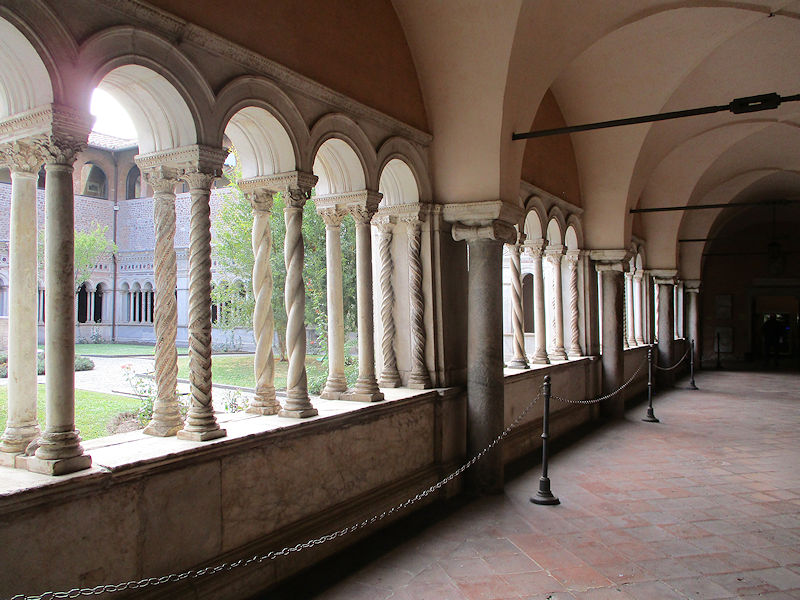
Who among us doesn't love the sight of twisted marble columns?

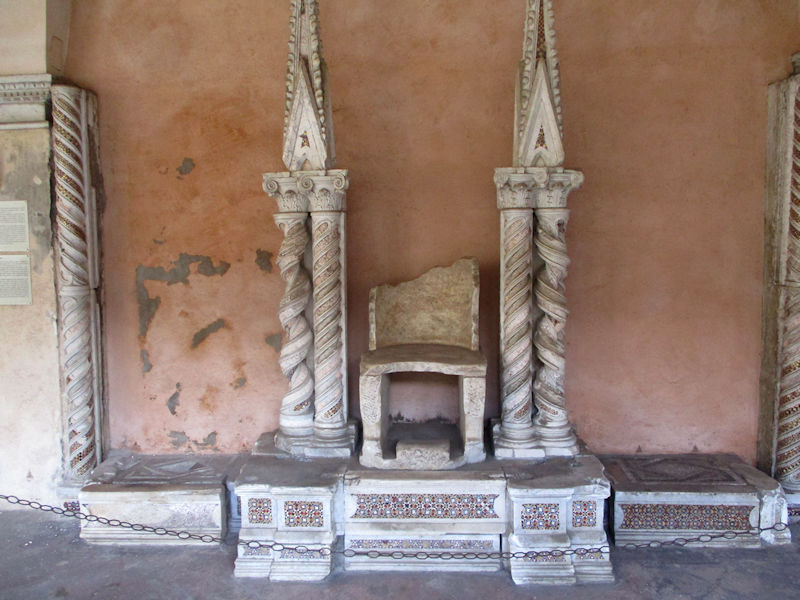
This is the 'Altar of Mary Magdalene', consecrated on the orders of Pope Boniface VIII in 1297. During Francesco Borromini's work on the nave, it got smashed up a bit and what was left ended up here, though the seat itself, said to date from Roman times, was put out front of the basilica for some parts of the ceremonies for new popes, from 1099 to 1560. Even for great fans of Mary Magdalene, like us, it's not really clear why she would have needed a throne and altar of her own.
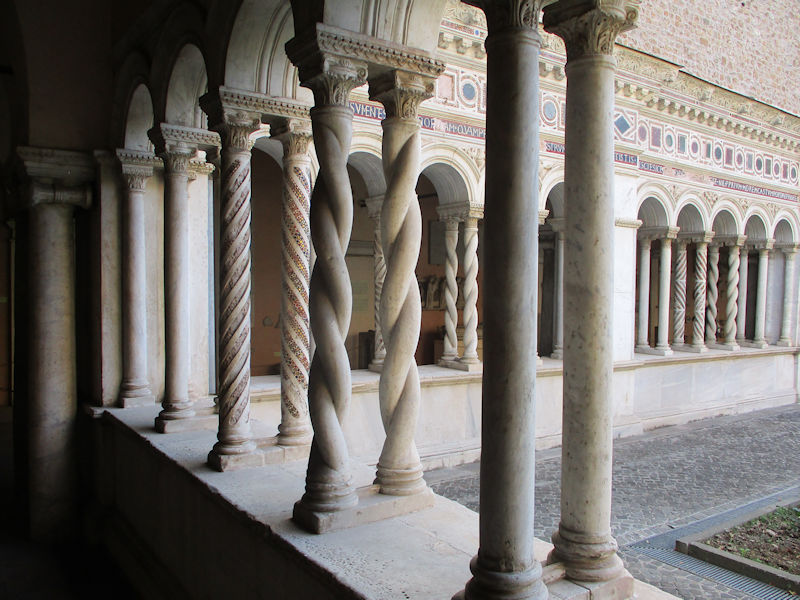

-- Nobody really likes being dead, but one doesn't need to look so glum about it.
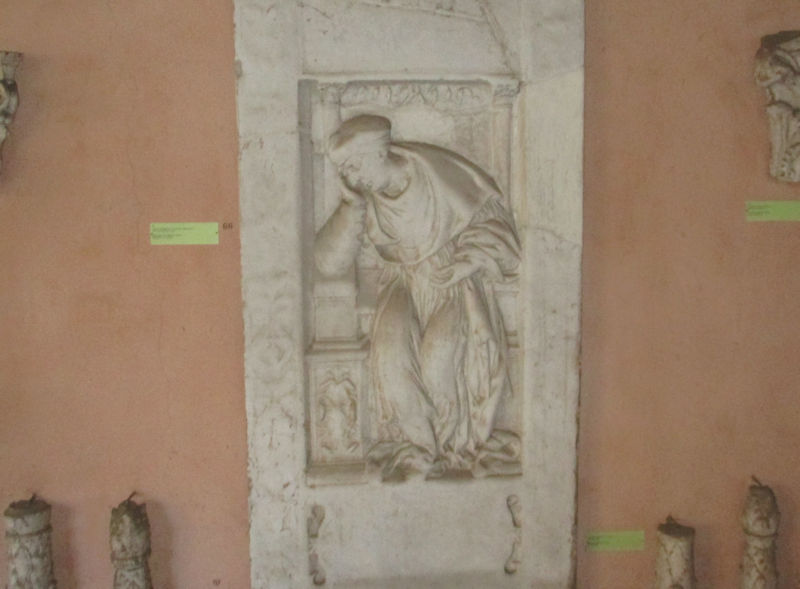
-- Just try to think about it as having a nice nap.
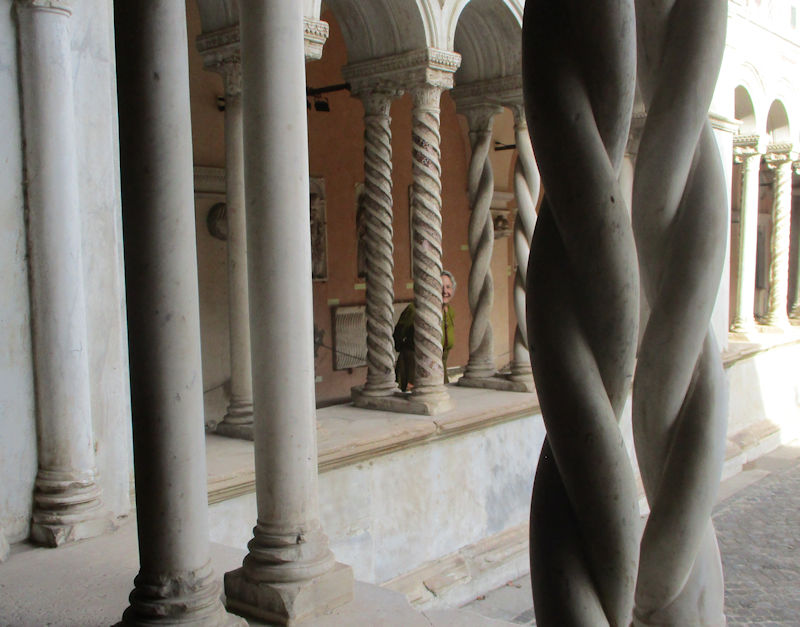
Peek-a-bo

Facing the front of the Archbasilica, just across the Piazza di San Giovanni in Laterano, this is the Porta S Giovanni breaching the city's Aurelian Walls, which were built in AD 271-275 to supersede the 4th century BC Servian Wall by enclosing all of the seven hills of Rome and the Trastevere neighborhood across the river, as well as the whole Campus Martius.

The St John Gate from outside the walls. With the modernizations of the Lateran area to accommodate increased traffic from the city out to southern Italy, much of the neighborhoods here both within and outside of the walls were reorganized, and this simple monumental gate was built for Pope Gregory XIII and inaugurated in 1574. It is meant to be decorative and lacks the medieval-style fortifications of the Aurelian era Porta Asinaria alongside, which was no longer fit for purpose. The flanking arches for cars and pedestrians were added in 1926 as part of a wholesale renovation of the whole quarter outside the gate.
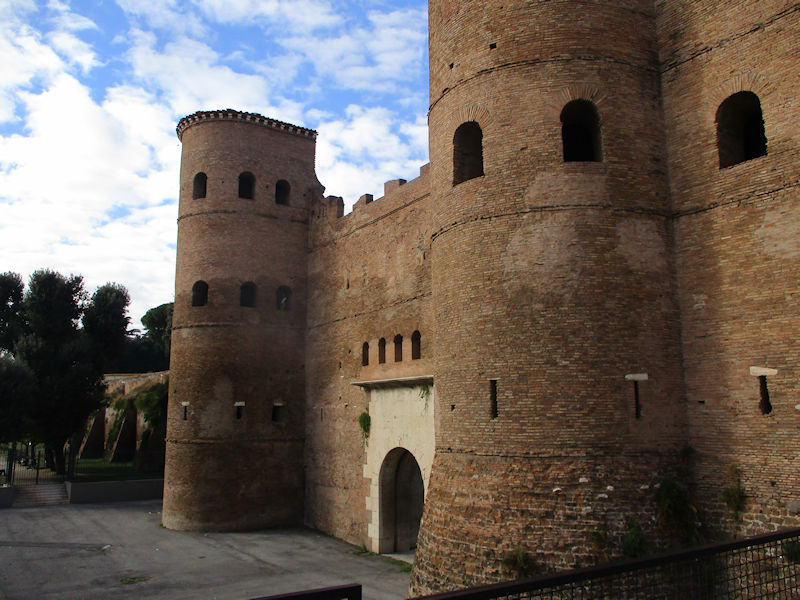
This is the obsolete Porta Asinaria, built with the Aurelian Walls to cover a secondary road passing out through the Asinii family estate, from which it may have got its name. Later, a few years before Alaric's Sack of Rome in AD 410, it was elevated to one of the city's main entrances, with a heightening of its walls and towers. It continued to serve its defensive functions for many years, with alterations as siege techniques evolved, but was finally blocked by Pope Pius IV in the early 1560s, to be replaced by the St John's Gate and eventually covered by a landfill, which was cleared up in the 19th century.
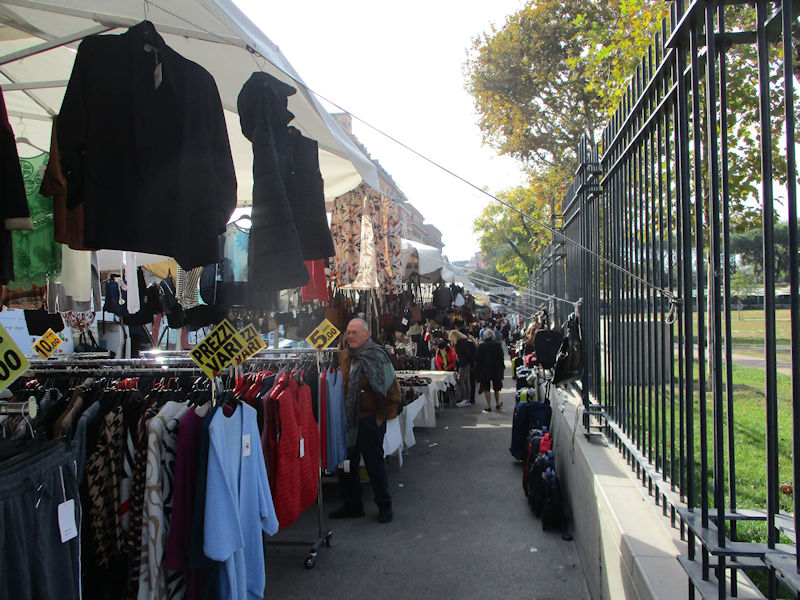
That's the street market running along 160 meters just outside the Via Sannio gardens abutting the Aurelian Walls. Kristin can't notice a street market without a knowledgeably inquisitive look through what's on offer.
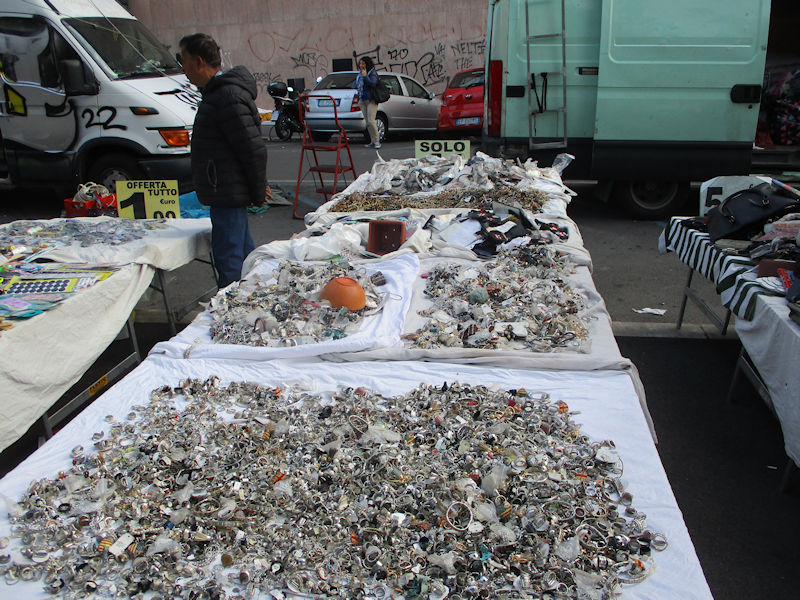
-- Fancy some jewelry? Top quality! Really!
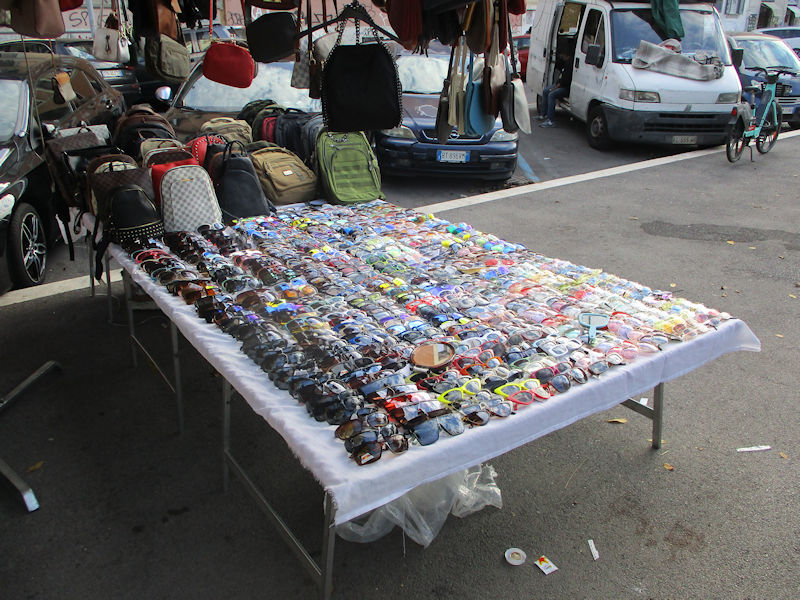
-- Or sunglasses! How about some sunglasses?!

It appears that it was through this Asinaria Gate that the Byzantine general Belisarius entered Rome during the so-called Gothic Wars (535-553), though a few years later the Gothic Totila came through the same gate to take it back. The Norman warlord Robert Guiscard partially wrecked it in 1082, but it remained one of the city's main gates through the 15th century.
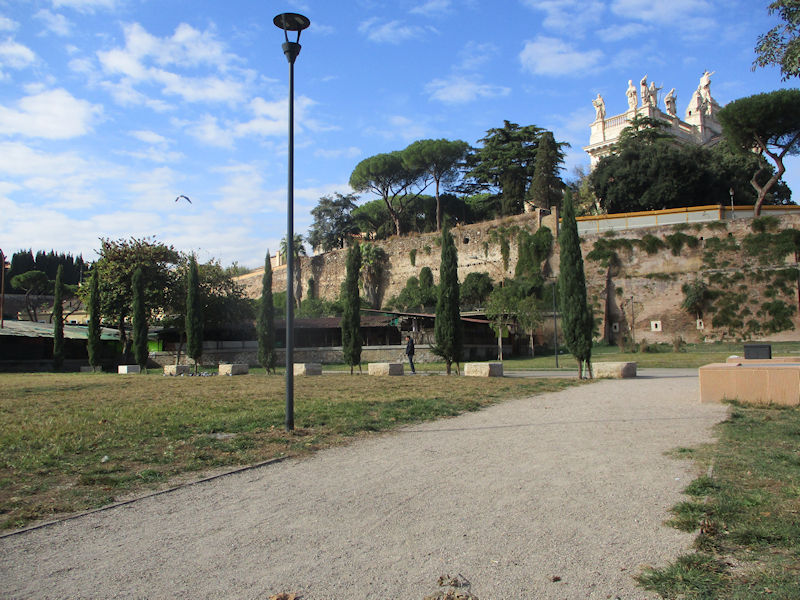
The Giardini di Via Sannio, reopened by Mayor Raggi on 18 February 2021 after long construction works on the city's third subway facility. It includes a display of archaeological finds made during excavation works for the subway.
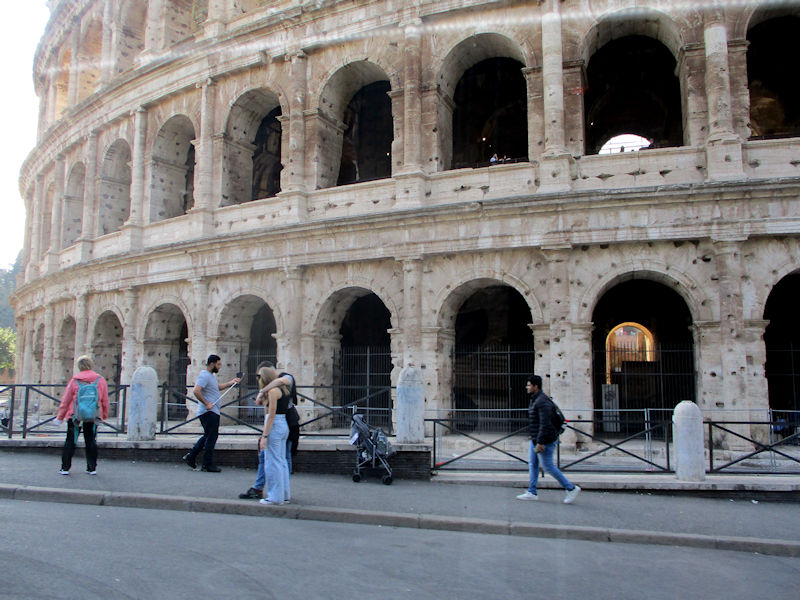
That's our bus ride down past the Colosseum, but bad luck! When our bus hauled us round the other side of the Lateran Basilica, we passed right by the Piazza John Paul II which hosts the octagonal San Giovanni in Fonte baptistery, built by Constantine along with the Basilica, though a bit separated from the back of it, now with improvements by Borromini.
Not only that -- planted virtually on the curb is the Lateran Obelisk, made c.1400 BC in Karnak but in 457 transferred to the Circus Maximus in Rome. In time it fell over, but was resurrected on orders from Sixtus V in the 1580s. It was placed here to replace the equestrian statue of Marcus Aurelius that was shifted down to the Campidoglio in 1538. It's said to be the largest standing Egyptian obelisk in the world, and we passed right by it trying to wrestle a Canon PowerShot out of our trouser pocket.
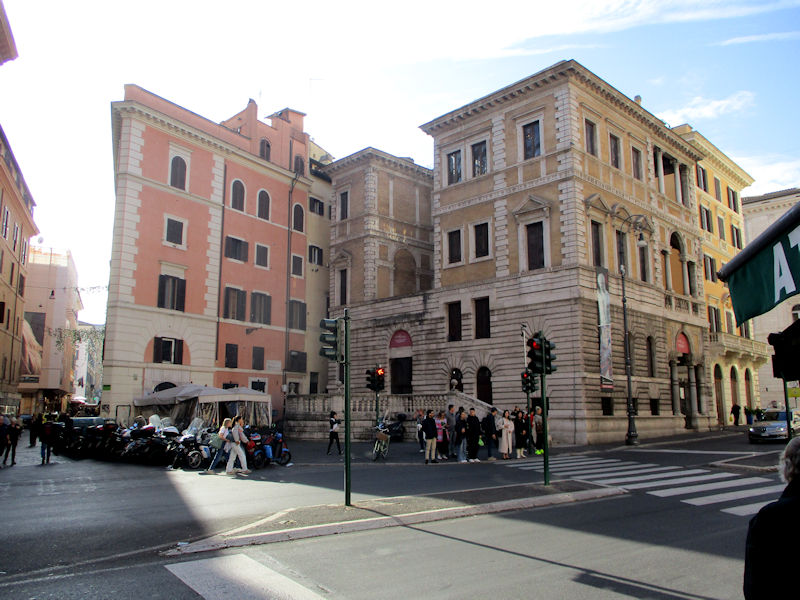
Late in the day, we're hoofing it down the Corso Vittorio Emanuele II, past this 'elegant 16th century palace' that's presently a museum of 'ancient sculptures and artwork from Egypt, Cyprus, and Greece'. No time for that, we're in a hurry.
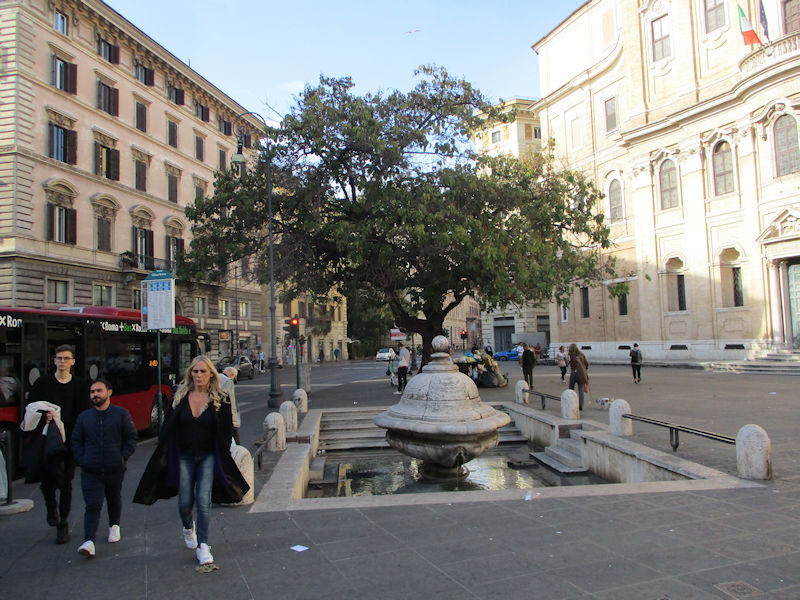
Right past the Piazza della Chiesa Nuova, where the available taxis hang out, just two blocks from our wine/beer Coop and the Via Giulia -- Joe and Teny are arriving tonight from Switzerland, and we need to straighten up the accommodations.
 Dwight Peck's personal website
Dwight Peck's personal website

































 3
3





















































